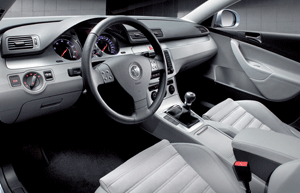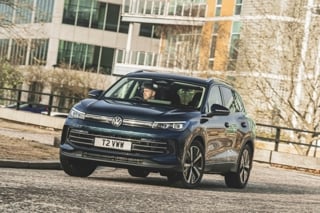Review
The sixth generation Passat continues that trend.
At 62mm longer, 74mm wider and 10mm taller than its predecessor, it is also considerably larger than competitors such as the Ford Mondeo, Volvo S60 and BMW 3-series.
One obvious benefit is a spacious interior. This is helped by the replacement of the traditional handbrake with an electronic one, operated via a switch on the dashboard. It can also act as an emergency brake, applying 70% of full brake force when pushed while driving.
Consequently, on all but entry-level models, the space between the front seats is dedicated to a larger armrest with an air-conditioned storage box.
The glovebox is also air-conditioned, and incorporates a hidden drop-down tray used to store a CD-autochanger if fitted.
Large door bins, in-dash drawers and an umbrella holder in the driver’s door provide further storage, and the boot will swallow 485 litres of luggage. In fact, this new Passat is as much mini-MPV as saloon.
Externally, the Passat has a more fluid shape than the old model, and draws influence from VW’s recent design studies such as the Concept R roadster and Concept C coupe-cabriolet.
It is the first model to feature VW’s new ‘face’, which utilises a chrome radiator grille to form the point of a V-shape which flows up along the bonnet.
Another first for the Passat is the use of LEDs in the rear lights and side repeaters. When combined with a bold paint colour, these design details give the Passat a strong and upmarket appearance.
That’s ideal for competing against Volvo, BMW and Honda, but will it also step on the Audi A4’s toes?
Customers can choose between four trim levels – S, SE, Sport and SEL – and four engine variants from launch, with three more engines available later this year.
The entry-level S specification has a decent level of equipment, including VW’s press and drive ignition system, front and curtain airbags, alloy wheels, air-con and a fully adjustable steering column. At SE level, the car gains cruise control, electric rear windows and an electrically-adjustable driver’s seat.
The Sport is distinguished by sports suspension, 17in alloy wheels, sports seats, tinted rear windows and front foglights while the top-spec SEL, available from September, has a raft of standard conveniences such as footwell illumination, heated front seats, two-zone climate control and a CD-changer.
Volkswagen UK expects to sell 19,000 Passat saloons plus a further 13,000 estates (launched this November) during 2006, with four-fifths of them powered by turbo-diesels. Corporate sales are expected to account for two-thirds of the volume.

Behind the wheel
We completed the same test route in the two turbodiesels and the 2.0 FSI (1.6FSI was unavailable at press launch).
The Sport trim’s lowered suspension and 17in alloys with 45-profile tyres generate a lot of road noise and transmit every little bump and ridge through the car, making the ride uncomfortable.
The other models with 16in alloys are more relaxing and still cope adequately with bends once off the main roads.
Model of choice is the 2.0TDI with its six-speed gearbox. It’s a good compromise between economy and power and is likely to be the biggest seller in the UK. The 1.9TDI manages better mpg but lacks the flexibility of its bigger brother, and the 2.0FSI can’t match on economy.
Strengths: Upmarket look, uncomplicated controls, insurance group 7
Weaknesses: Concern over initial trim quality
Opportunity: Attract business user-choosers
Threat: Auto not until July, top-spec SEL not offered until September
USP: Bigger is better
Prices: £14,495 - £19,810
Engines: At launch: 1.6 FSI, 115bhp; 2.0 FSI, 150bhp; 1.9TDI, 105bhp; 2.0TDI, 140bhp To come: 2.0TDI, 170bhp; 2.0FSI, 200bhp; 3.2 FSI V6, 250bhp
Transmissions: 5sp/6sp man, (6spd Tiptronic from Sept, 6spd DSG from Nov)
Performance: 0-62mph 9.4-12.1secs, top speed 117-132mph
Efficiency: 33.6-48.7mpg combined; 157-202g/km CO2
Rivals: Mondeo, Vectra, 3-series, S60, Accord, A4

Factsheet
No information available.














